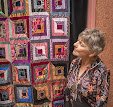Yosegire – Symbolism in 16th Century Japanese Patchwork
Patchwork in Japan has historically had religious significance. In Shinto, the predominant religion, all things animate and inanimate are believed to be imbued with a spirit, and this of course includes textiles. In ancient times fabric was so highly valued as to sometimes be used as a form of currency and fabrics were given as tribute to emperors and warlords. Even today old textiles have symbolic meaning: the giving of a patchwork garment, for example, conveys a wish for long life for the recipient, while the care and preservation of textiles is seen as a spiritual exercise. My padded and quilted patchwork dressing gowns are inspired by the 16th Century Japanese patchwork style known as ‘yosegire’. The word means ‘the sewing together of different fragments’ and is a form of what we in the West would describe as ‘crazy patchwork.’


1 comment:
Your (patch)work is wonderful!
Have you some yosegire dressing gowns designed (as promised!)for women?
Post a Comment